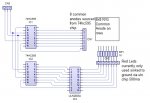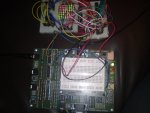Hi All,
Background:
I have been playing around with a 8x8 Red/Green Led matrix (common anode) module, just driving the red leds at present, via two 74hc595 and 1 uln2803a, one 595 provides + for common anodes (rows) other is paired with the uln to sink to ground for the columns, using a 20x2 and using the hspiout command and getting great results running at set freq m64 I am not getting any flicker but due to the 1k resistors the leds are quite dim, at the moment I am playing it safe as although my sink end (uln2803a) can handle 500ma the 74hc595 i believe can only handle a 70ma max and with a potential situation of 8 leds being lit at once, I would like to include something extra to provide a higher current to these leds.
Advice:
I like using the 74hc595 chips and would like to still use these as i have them to hand as I have seen the higher rating shift registers, componant count is not an issue so is there something i can construct after the 74hc595 to be able to source a higher current, like how i have on the sink side of things.
Future:
Eventually once happy I will also add another 74hc595 and uln2308a for the green columns, then move onto a full rgb led matrix.
Image:
Image attached to give an idea of current layout.
*note. I have not included all the wired links etc just for a rought idea purposes.
Current Code:
just my test code for lighting a few of the leds animated between two sets with a for/loop just for delay.
Thank you for your time having a look over this.
Kind Regards
Nick
Background:
I have been playing around with a 8x8 Red/Green Led matrix (common anode) module, just driving the red leds at present, via two 74hc595 and 1 uln2803a, one 595 provides + for common anodes (rows) other is paired with the uln to sink to ground for the columns, using a 20x2 and using the hspiout command and getting great results running at set freq m64 I am not getting any flicker but due to the 1k resistors the leds are quite dim, at the moment I am playing it safe as although my sink end (uln2803a) can handle 500ma the 74hc595 i believe can only handle a 70ma max and with a potential situation of 8 leds being lit at once, I would like to include something extra to provide a higher current to these leds.
Advice:
I like using the 74hc595 chips and would like to still use these as i have them to hand as I have seen the higher rating shift registers, componant count is not an issue so is there something i can construct after the 74hc595 to be able to source a higher current, like how i have on the sink side of things.
Future:
Eventually once happy I will also add another 74hc595 and uln2308a for the green columns, then move onto a full rgb led matrix.
Image:
Image attached to give an idea of current layout.
*note. I have not included all the wired links etc just for a rought idea purposes.
Current Code:
just my test code for lighting a few of the leds animated between two sets with a for/loop just for delay.
Thank you for your time having a look over this.
Kind Regards
Nick
Attachments
-
55.5 KB Views: 56
-
771 bytes Views: 7


